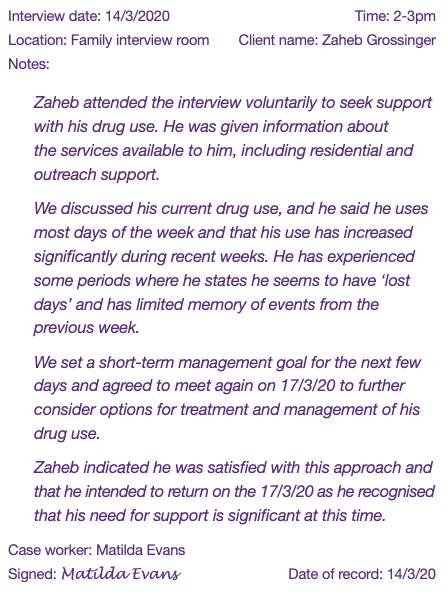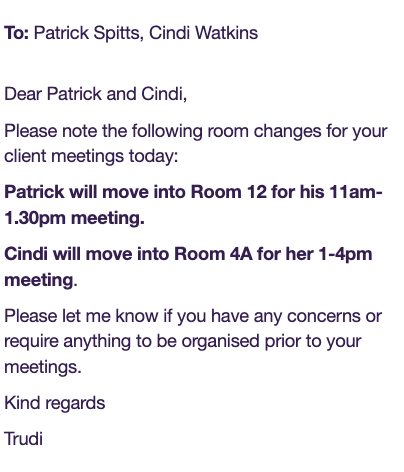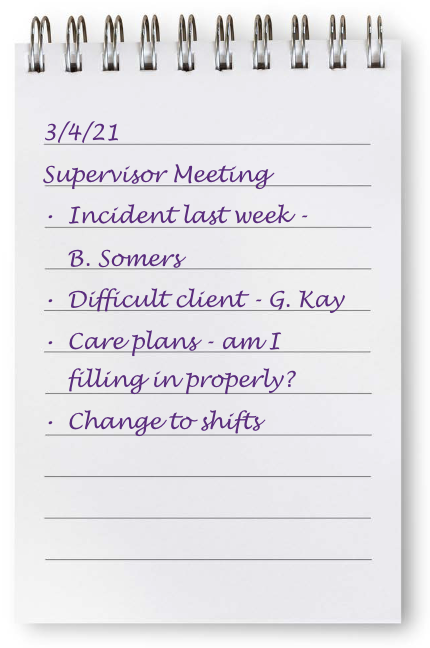Workplace documentation is vital to ensure accurate recording keeping, sharing of information, maintenance of funding data requirements and adherence to sector wide standards and expectations. Workplace documentation must be completed regularly, in line with the policies and procedures of your organisation.
By the end of this topic, you will understand:
- Workplace documents you may need to complete and why they’re important
- How to read documents related to your own role3How to complete documents to organisational standards
- What you need to consider in relation to your organisation’s brand and digital media
- How and when to document events
- Common conventions for recording information
- How to record a summary of information
- Meeting funding body record keeping requirements.
Each workplace will have its own set of requirements around the documentation it requires it's staff to complete. However keeping accurate records will be a key part of your role. You must be sure you understand the organisation's policies and procedures around record keeping that relate to your role and that you follow them.
Many records are kept and maintained by organisations to meet legislative requirements. Your organisation will have specific policies and procedures which guide the way you must complete workplace documents and records.
This can apply to areas of work such as:
- Completing your timesheet and recording hours of work.
- Making case notes after an interaction with a client.
- Making appointments and bookings.
- Reporting incidents and issues.
- Documenting referrals for services.
- Maintaining data about hours of service, client numbers, outcomes and achievements.
- Team meeting minutes and agendas.
You should follow the policies and procedures which explain why you should complete documentation in a specific way. You may use online or intranet-based record keeping and documentation for tasks or print based.
You should check that you comply with the specific requirements of each procedure, such as:
- Writing in blue or black pen.
- Completing all sections of the document.
- Checking you have signed and dated the document if needed.•
- Writing in legible handwriting.
- Using clear, precise language.
Example
Matilda needs to fill in some notes from an interview with a client. She reads the procedure for case notes which tell her she must:
- Sign and date the notes in the space provided.
- Write using handwriting in blue or black pen, or typed notes.
- Inform the client that the notes will be stored securely, and that the client can access the notes on request.
- Inform the client that she will be taking notes during the interview.
- Use clear, specific note taking and avoid any subjective or biased opinions which are not evidence based.
Here are Matilda's notes for the interview:

Activity
Imagine you are a case worker who has the task of writing notes following an interview on 14 June with a young person, Ben Crispin, who is socially isolated and has recently moved out of home.
He has left school, is not attending further education and does not have a job. His funds are limited, and he has not accessed income support payments.
He has spent the past week on a friend’s couch, but the friend’s mother has now asked him to leave.
Ben has come to see you to help find new accommodation and to plan his finances.
Questions:
- Highlight the critical information in the case information.
- Type a set of case notes using this information.
- Sign and date your case notes.
Example/Case Study
Trudi oversees making client appointments for the case workers at her service. She needs to make sure everyone can read and follow the appointments and that there are enough rooms available for sessions to be booked, without having any room clashes.
Here is her booking sheet for today:

Trudi looks at her booking sheet carefully and realises she has some rooms which have been double booked. She decides to move Cindi Watkins into Room 4A instead of Room 7, and she moves Patrick Spitts into Room 12.
She sends an email to each worker to confirm the room changes for the day:

When you begin in a community services or health workplace, you will mainly focus your attention on documents and information which relate specifically to your own job.
Although there are likely to be other documents within your workplace, it makes sense to think first about the documents which are most relevant to you.
These could include:
- Case notes for your own clients.
- Team meeting agendas and minutes.
- Emails from your supervisor and co-workers.
- Your position description.
- Policies and procedures which relate to your job.
Careful Reading
Take your time when you are reading workplace documents.
It is a mistake to skim quickly over a document because you may miss important details such as names, dates, times and places. Read carefully and think about whether you should take notes or make a summary of what you have read.
It might be useful to make simple notes about a document that can help you remember the important details.
Example
Elizavetta reads an email from her supervisor about a team meeting:

You should always ask your supervisor for assistance if there is information in a document you do not understand.
Some workplace documents are complex and detailed or contain critical instructions which must be followed precisely. It is better to ask your supervisor to explain information you do not understand than to pretend or simply ignore a document completely.
Example
Pauline has been reading the Material Safety Data Sheet (MSDS) for a cleaning chemical she is about to use to clean the table in the meeting room. She can understand some of the information, but she is not sure what personal and protective equipment she should use.
She decides to ignore the MSDS because she thinks she will only be using the cleaning product for a short time, so there is unlikely to be any harm. Unfortunately, the information Pauline has ignored contained guidance about using the product in a well-ventilated area only, and that users should wear a mask and eye protection.
Pauline keeps the doors and windows closed while she cleans, and later finds she is experiencing a severe headache and nausea. She tells the First Aider, who fills out an incident report form and sends her to see her doctor straight away.
Pauline realises she should have asked her supervisor to clarify the information in the MSDS document before she began cleaning the room.
Your organisation will have an expected standard for written and electronic documents. These are often included in the policies and procedures of your workplace, but you can also ask your supervisor for guidance if needed.
The standards of your organisation may also be implied, rather than being directly stated in policies and procedures. Look at the work completed by others in the organisation who hold similar roles to your own. Compare their standard of work with the policies and procedures which you know apply to the tasks and see what standard is expected.
Standards for Electronic Documents
Some standards will relate to electronic documents. When we talk about standards, we mean the set of expectations that your organisation expects. Standards are useful for ensuring that legislation, or the law, and your organisation’s requirements are maintained and that documents are user friendly and accessible.
Many people prefer to read documents which are well laid out, clear and easy to read. Some people find documents that include images with captions and a clean simple font easier to read.
Standards for electronic documents might include:
- Using a certain font and size.
- Avoiding coloured backgrounds.
- Limiting the amount of movement and animation on a page.
- Making navigation features obvious and intuitive.
- Including options for text to speech and Plain English versions.
- Matching the document features to the audience.
The standards which are required for electronic documents will vary depending on the intended audience and the type of work undertaken by your organisation.
For example, if you provide services to many people who are elderly, you may need to provide documents which have a larger font, more traditional styling and limited animation. If you provide services to a younger age group, you may need to increase the use of video and audio and add more colour and movement to increase the visual appeal and engagement of the document.
Standards for Written Documents
Just like electronic documents, it is important to think about the needs of the audience when preparing a written document. Your organisation is likely to have requirements for the preparation of written documents, and you should check the policies and procedures which will guide you.
Standards and requirements could include:
- Version control information.
- Whether the document is available to anyone in the workplace or has a limited purpose.
- Whether the document can be printed and used.
- Whether there is an electronic version available.
- What the intended purpose of the document is.
- Including a footer, logo and slogan or other branding features.
Some documents are only for use within the organisation whilst others are designed for external use and can be read by anyone in the general public.
It is important to check how a document is allowed to be used as some information should not be shared with the general public due to its confidential nature.
Version Control
Workplace documents such as reports, policies, procedures and project plans include a version number or code. This tells the reader which version of a document they are reading. Version control is useful if a document is drafted and edited several times, or if it is written by more than one person over a period of time.
Many organisations have a brand or identity that they maintain through their documents. This helps the general public to recognise information which has been sourced from the organisation and builds recognition of the work of the organisation more generally.
Brand features can relate to:
- Logo
- Slogan or key phrase
- Colours
- Font size
- Font style
- Headers and footers
Brand features are usually common across written and electronic documents. Many workplaces will use a template system for letters, flyers and publicity documents to help workers maintain the branding which is required by the organisation.
Activity
- Go online and research three community services or health care organisations.
- Make notes about the brand features you notice on their website and written or electronic documents.
- Prepare a summary and write a paragraph explaining the strengths, weaknesses and interesting features you notice for each one.
Most workplaces are aware of the challenges posed by digital and social media for workers, clients and the organisation.
Even though digital media is extremely useful for promoting a business, information sharing and communication, it also presents challenges. These can range from lack of appropriateness of content through to readability issues, cultural relevance and use of images of children.
The digital media landscape is a rapidly evolving one, and it is important to think, read and plan carefully when using or creating any digital content.
Digital Media Use
Some workers are very familiar with the digital world and can quickly and easily create highly visual, engaging content that has strong appeal for an audience.
They may be frequent users of social media or have developed excellent digital skills at school or through further training. This familiarity can lead to a lack of caution when creating content. This causes difficulty recognising the difference between the rules which govern private use of social and digital media and the rules which apply in the workplace.
It is important to be aware that just because you are familiar with digital content and use it frequently in your personal life, does not mean you should be as casual about how it is used when using it on behalf of your organisation.
Remember that your workplace is very different to your personal life, and there should be clear and firm boundaries which are maintained between the two.
What Not to do
It can be tempting to share posts, ideas and photos just the way you do with your own social media in your personal life. But it is important to remember that there are some things you must not do with electronic and social media at work:
- Post personal, rude, discriminatory or distressing comments.
- Use images of a person without their permission.
- Breach privacy or confidentiality rules.
- Breach organisational guidelines.
- Make derogatory comments.
What to do
There are many things you can and should do in the digital world, and you may find that your skills at using digital media can be a great asset to your workplace.
Some things which are useful that you can do include:
- Sharing images of activities or places with permission from anyone who can be identified.
- Sharing general information about programs, services and activities.
- Maintaining a social media page with up to date information.
- Linking with other professionals in related services or areas.
- Developing a strong, positive network.
- Posting news stories, articles and tips that can be informative and helpful.
Whenever you use digital media, make sure you check the policies and procedures of your organisation before you click ‘post’ to ensure you are adhering to organisational standards, brand identity and appropriate confidentiality policies.
Example
Roger works for a youth justice organisation. He wants to promote the positive achievements of a young person who has recently completed a training program at a local TAFE.
Roger checks the policy and procedure for his organisation and finds that he is able to promote the program’s activities through the social media page. He follows the guidelines in the procedure which set out the steps:
- Contact the supervisor for permission and to discuss the story.
- Contact the young person and their parent/guardian.
- Have the young person and their parent/guardian fill out and sign a permission form.
- Write a draft of the story.
- Show the draft to the young person, their parent/guardian and the supervisor.
- Have the draft approved by all parties before publishing it online.
- Roger completes the steps and then publishes the article. It is very popular and, best of all, the young person is very excited to read about themselves in the post.
Many tasks in community services and health care require documentation.
You often need to record actions, outcomes, goals and progress information. This information may be used by yourself as a way of staying up to date with progress and actions in relation to a client over time. It may be used by others who receive a referral for a client, or who access the information you have recorded to help them provide a service.
When you document events, you should complete the information in a required format. This format is common to many workplaces, although your own organisation may also have rules that you should follow.
Here are some of the conventions for completing documentation for case notes, client records, referrals and individual plans and assessments:
| Convention | What to do |
|---|---|
| Name | Include your own name so people know who has made the document or note. |
| Date | Include the complete date so it is easy to check when a record has been made and records can be maintained in a sequential order. |
| Signature | Some documents or notes require a signature, which should be made in blue or black pen. |
| Past tense | Documents such as case notes are often written in the past tense. |
| Objective | Keep your writing objective rather than including your own opinions and values. |
| Details | Include details relevant to the situation and the task or work you are doing and leave out non-relevant details. |
| Accuracy | Check your work for accuracy, so that you are confident the details are correct, and you have not included anything which is incorrect. |
| Courtesy copies and referrals | Check if the document needs to be copied and sent to another worker or organisation as a courtesy, or if you should attach a referral form or letter. |
Summaries are written documents and are often less formal and structured than documents which require a specific convention to be followed.
They provide a brief outline or description of a situation, activity or task. Summaries only include the main points, rather than all the information.
You can use a written summary in situations where:
- You do not need to record all the details.
- You require a brief reminder or prompt about a situation or task.
- You will find a small amount of information helpful.
Summaries can be used in situations such as helping you prepare for a meeting or case conference, providing a brief outline of an incident or near miss, and reminding you of points you need to discuss with a supervisor or colleague.

Some programs are funded by state or federal governments through programs or grants.
If you are involved in working on a program which is funded by government, you may need to complete documentation in relation to the program.
You will need to follow the requirements set out by the funding body, and make sure you comply with the timelines for reporting that they set.
Reporting may include:
- Writing a summary of outcomes for the period the funding is provided.
- Confirming that your program has met the objectives.
- Stating how much money has been spent during a time period.
- Giving detailed information about achievements.
- Providing details of staffing, hours and resources used.
You may need to provide written information to meet funding body requirements or submit information online through a secure portal or website.
Key Points
- Follow organisational requirements when completing documents at work.
- Seek advice and guidance for documents and requirements in situations where you are unsure.
- Read and understand documents related to your position and work role.
- Use clear, accurate and objective language.
- Documents may include summaries and reports for funding bodies.
- What is a MSDS and what information might you find on one?
- Why is version control on a document important?
- Why is it important that records are kept in a community and health service organisation?
- Write down some examples of when you might use a summary of information rather than detailed notes.
